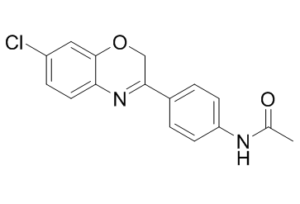QX77 is a novel and potent chaperone-mediated autophagy (CMA) activator. The lysosomal storage disease cystinosis, caused by cystinosin deficiency, is characterized by cell malfunction, tissue failure, and progressive renal injury despite cystine-depletion therapies. Cystinosis is associated with defects in chaperone-mediated autophagy (CMA), but the molecular mechanisms are incompletely understood. Treatment of cystinotic cells with a CMA activator increased LAMP2A localization at the lysosome and increased cell survival. Altogether, we show that LAMP2A trafficking is regulated by cystinosin, Rab11, and RILP and that CMA up-regulation is a potential clinically relevant mechanism to increase cell survival in cystinosis.
Physicochemical Properties
| Molecular Formula | C16H13CLN2O2 | |
| Molecular Weight | 300.739622831345 | |
| Exact Mass | 300.066 | |
| CAS # | 1798331-92-6 | |
| Related CAS # |
|
|
| PubChem CID | 118129505 | |
| Appearance | Light yellow to yellow solid powder | |
| LogP | 2.9 | |
| Hydrogen Bond Donor Count | 1 | |
| Hydrogen Bond Acceptor Count | 3 | |
| Rotatable Bond Count | 2 | |
| Heavy Atom Count | 21 | |
| Complexity | 419 | |
| Defined Atom Stereocenter Count | 0 | |
| SMILES | ClC1C=CC2=C(C=1)OCC(C1C=CC(=CC=1)NC(C)=O)=N2 |
|
| InChi Key | PYCTUCLCTVWILY-UHFFFAOYSA-N | |
| InChi Code | InChI=1S/C16H13ClN2O2/c1-10(20)18-13-5-2-11(3-6-13)15-9-21-16-8-12(17)4-7-14(16)19-15/h2-8H,9H2,1H3,(H,18,20) | |
| Chemical Name |
|
|
| Synonyms |
|
|
| HS Tariff Code | 2934.99.9001 | |
| Storage |
Powder-20°C 3 years 4°C 2 years In solvent -80°C 6 months -20°C 1 month |
|
| Shipping Condition | Room temperature (This product is stable at ambient temperature for a few days during ordinary shipping and time spent in Customs) |
Biological Activity
| ln Vitro | In Ctns-/- MEFs, QX77 (48 hours) increases the expression levels of Rab11 [1]. Rab11-positive vector vesicles restored the high-motility transport phenotype of wild-type cells, and QX77 restored downregulated LAMP2A expression in Ctns-/-MEFs [1]. In cystine cells, treatment with the CMA activator QX77 prevented Rab11 downregulation and trafficking abnormalities. Additionally, LAMP2A's location on the lysosomal membrane is enhanced by QX77 treatment [1]. QX77 corrects the location of LAMP2A on the lysosomal membrane of cystine cells and dramatically promotes its relocalization to LAMP1-positive lysosomes in cystine cells [1]. QX77 restores the levels of resistance seen in wild-type cells while shielding cystine cells from oxidative damage caused by tert-butyl hydroperoxide. LAMP2A expression is required for QX77 to have an impact on cystine cell survival [1]. In D3 and E14 ES cells, QX77 (10 μM; 0, 3 or 6 days) downregulates pluripotency factors and AP responsiveness, increases LAMP2A expression, activates CMA, and partially loses typical ES cell shape [2]. |
| Cell Assay |
Western Blot analysis [2] Cell Types: ES D3 cell line; E14TG2a (E14) Cell line Tested Concentrations: 10 μM Incubation Duration: 3 or 6 days Experimental Results: LAMP2A expression increased, SOX2 and Oct4 protein expression diminished. |
| References |
[1]. Cystinosin, the small GTPase Rab11, and the Rab7 effector RILP regulate intracellular trafficking of the chaperone-mediated autophagy receptor LAMP2A. J Biol Chem. 2017 Jun 23;292(25):10328-10346. [2]. Chaperone-mediated autophagy regulates the pluripotency of embryonic stem cells. Science. 2020 Jul 24;369(6502):397-403. |
Solubility Data
| Solubility (In Vitro) |
|
|||
| Solubility (In Vivo) |
Solubility in Formulation 1: 10 mg/mL (33.25 mM) in 50% PEG300 +50% Saline (add these co-solvents sequentially from left to right, and one by one), suspension solution; with sonication. Preparation of saline: Dissolve 0.9 g of sodium chloride in 100 mL ddH₂ O to obtain a clear solution. (Please use freshly prepared in vivo formulations for optimal results.) |
| Preparing Stock Solutions | 1 mg | 5 mg | 10 mg | |
| 1 mM | 3.3251 mL | 16.6257 mL | 33.2513 mL | |
| 5 mM | 0.6650 mL | 3.3251 mL | 6.6503 mL | |
| 10 mM | 0.3325 mL | 1.6626 mL | 3.3251 mL |
